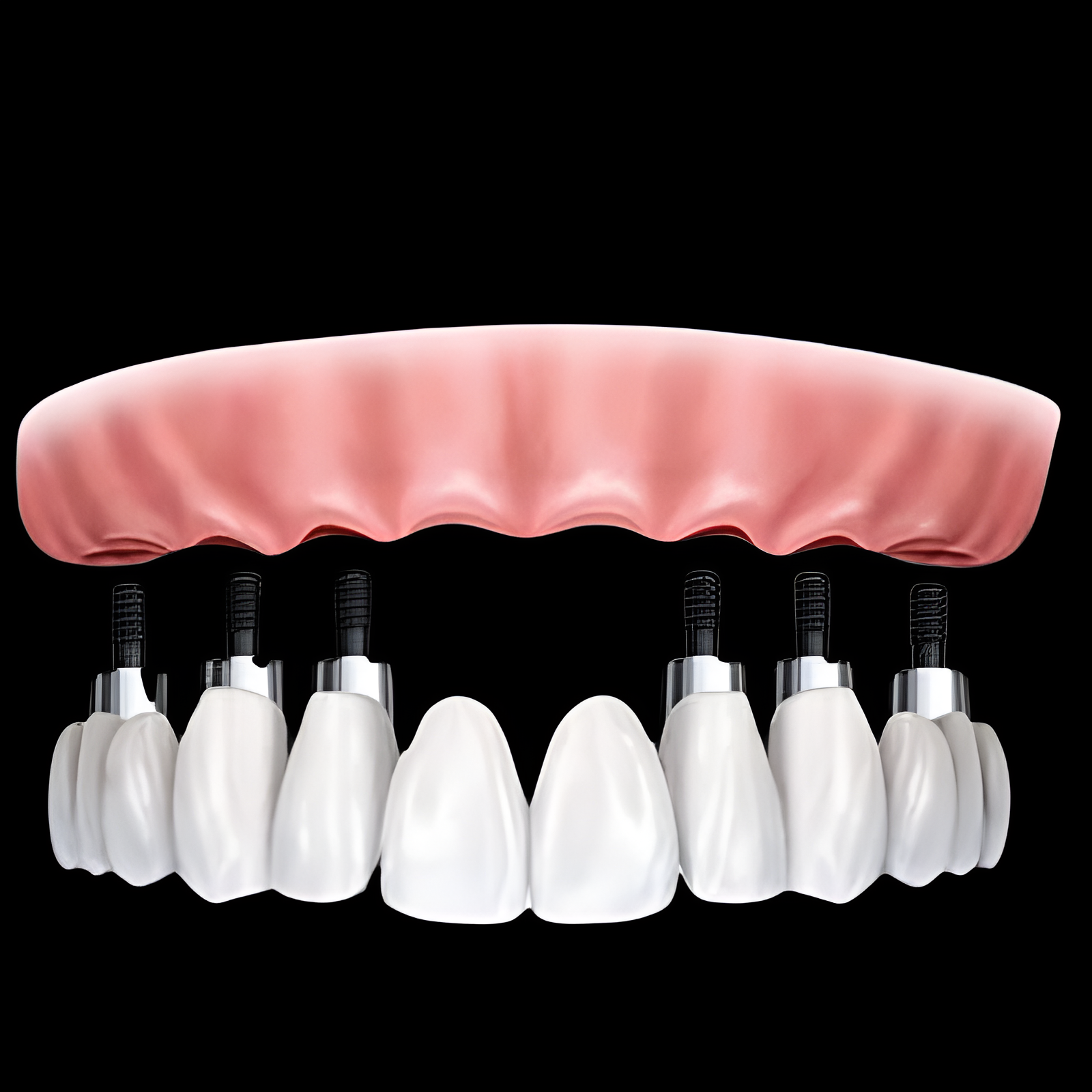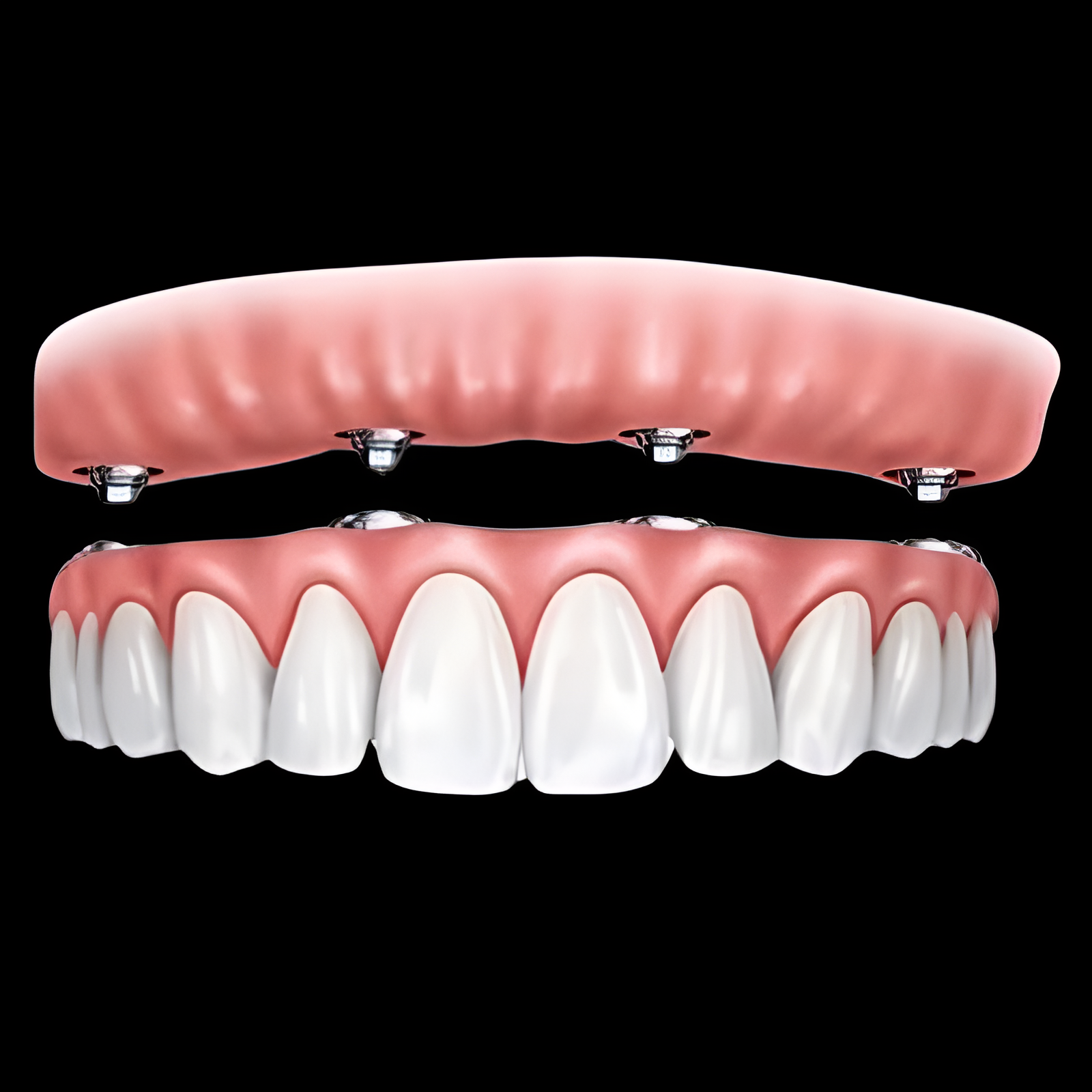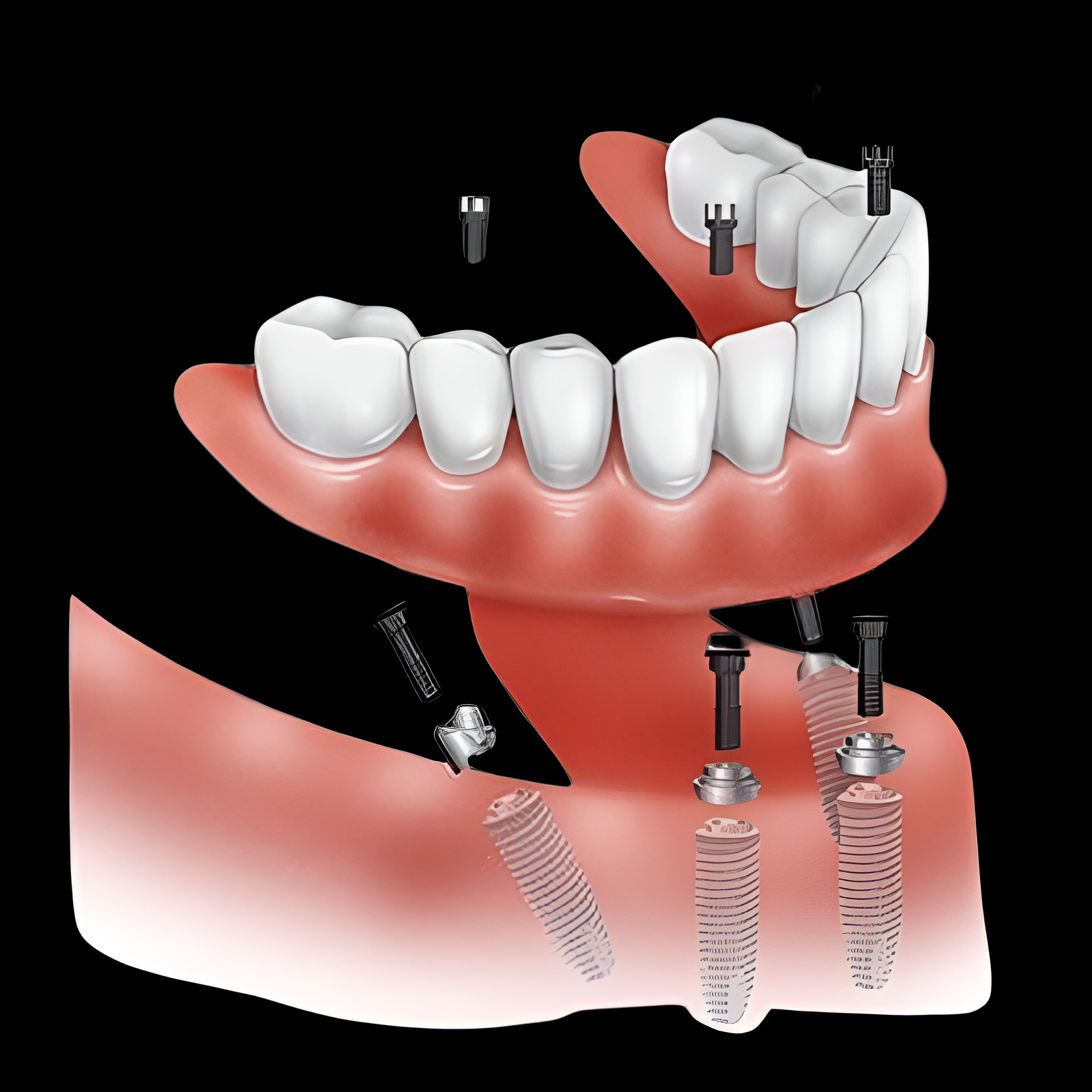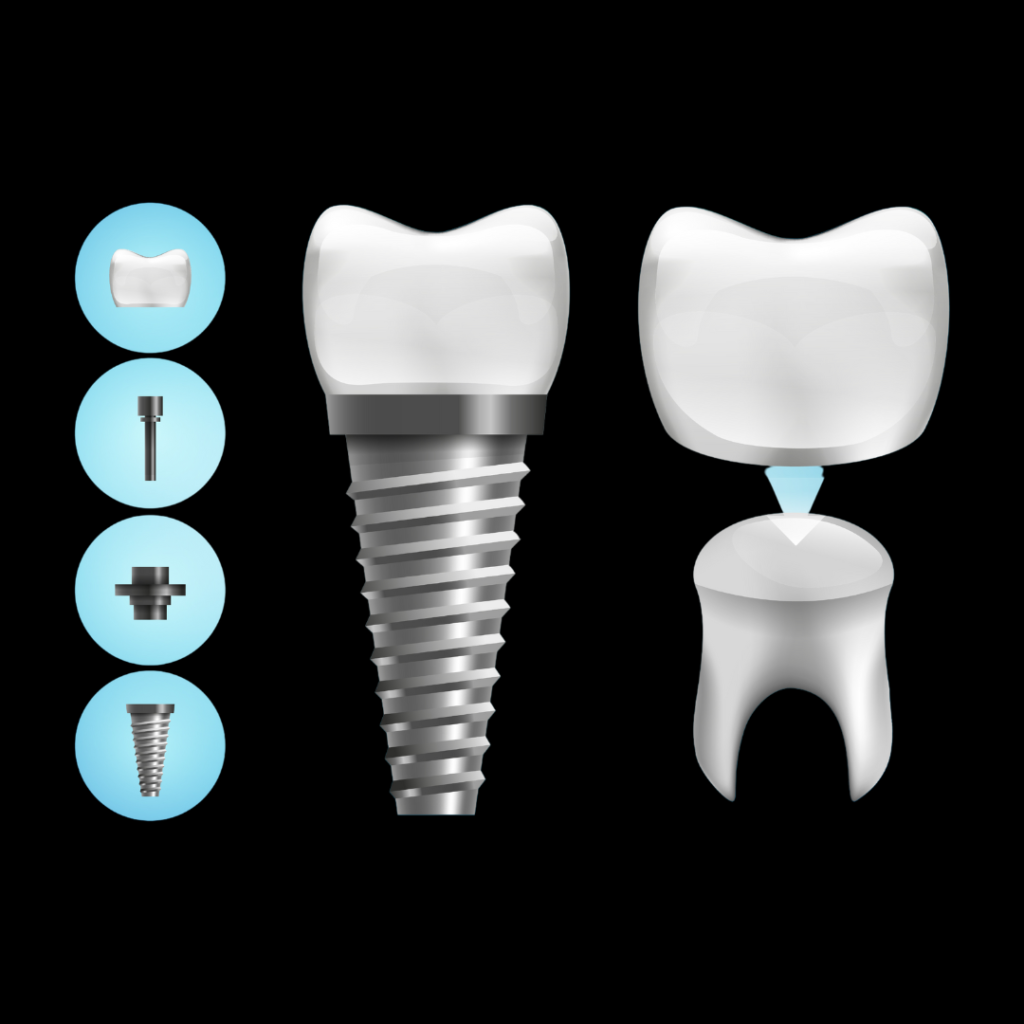What is All-on-4?
The phrase “All-on-4” refers to the installation of a full dental prosthesis on four implants. This method allows for the replacement of all teeth on one jaw with just four implants.
The prosthesis consists of a set of artificial teeth, usually made from porcelain or zirconia, securely attached to four implants. Two implants are placed in the front of the jaw, while the other two are angled in the back for maximum stability.

What problems does the All-on-4 method solve?
- Quickly addresses the issue of having many missing teeth, restoring a complete dental arch.
- Provides secure fixation of the prosthesis, eliminating movement and discomfort.
- The prosthesis looks natural, enhancing the appearance of the smile and boosting confidence.
- Restores full chewing function, allowing patients to eat their favorite foods without restrictions.
- Eliminates the need for removable dentures, which can cause irritation and inconvenience.
Indications and Contraindications for All-on-4
Indications:
- Total tooth loss: Patients who have lost all their teeth in one or both jaws.
- Inability to use removable dentures: Individuals for whom traditional removable dentures are not suitable due to discomfort or poor fit.
- Sufficient bone density: Patients with adequate bone density to support the implants.
- Desire for quick rehabilitation: Patients looking for a swift restoration of dental functionality and aesthetics in a single surgical procedure.
Contraindications:
- Uncontrolled systemic diseases: Such as uncontrolled diabetes or severe heart diseases, which can affect healing and implant integration.
- Extreme lack of bone density: Cases where bone density is insufficient and there is no possibility for bone regeneration to support the implants.
- Poor overall health: Patients with serious medical conditions that could complicate the surgical procedure or recovery process.
- Active oral infections: Presence of active infections in the mouth that could hinder successful implantation.
What Implants and Materials are Used?
The implants used in the All-on-4 procedure are generally made of titanium, a biocompatible material that integrates perfectly with the jawbone. The All-on-4 system includes several components:

Implants: Made of titanium, these serve as the foundation for securing the prosthesis.

Abutments: These are connecting elements attached to the implants, providing support for the prosthesis.
Materials Used for Teeth on Prostheses
When it comes to dental prostheses, the materials used for artificial teeth play a crucial role in determining the durability, functionality, and aesthetics of the dentures. Here are some of the most common materials used for teeth on prostheses:
Metal-Ceramic (Porcelain-Fused-to-Metal): Metal-ceramic teeth combine the strength of a metal core with the aesthetic qualities of ceramic. The metal framework provides excellent support and durability, making these prosthetic teeth highly resistant to fracture. The ceramic layer on top mimics the natural appearance of teeth, providing a pleasing aesthetic result.
Porcelain: Porcelain teeth are known for their most natural appearance and high durability. They are translucent under light, just like natural teeth, which ensures high aesthetics. Porcelain is also resistant to staining and wear, making it a long-term solution.
Zirconia: Zirconia is a high-strength ceramic that provides excellent durability and a natural tooth-like appearance. It is biocompatible and resistant to staining and wear. Zirconia is the strongest material used for dental prostheses, making it ideal for long-term use.
The choice of material for teeth on prostheses depends on several factors, including the patient’s budget, aesthetic preferences, and functional needs. It is important to consult with your dentist to determine the best material based on individual circumstances.
Stages of the All-on-4 Procedure
Initial consultation and planning:
The dentist performs a thorough examination of the patient’s oral cavity, including X-rays and a CT scan, to assess the condition of the bone tissue and identify possible hidden problems. Based on the data obtained, an individual treatment plan is drawn up.
Tooth extraction (if necessary):
If there are damaged or diseased teeth that must be removed before implant placement, the dentist performs the extractions. This is important to ensure a healthy foundation for future implants.
Preparation for surgery:
The patient undergoes necessary preparation for surgery, including testing and possible treatment of conditions that may affect the healing of the implants. The dentist also determines the optimal positions for the implants to ensure maximum support and stability.
Implant Placement:
During the surgical procedure, four implants are placed in the jaw. The procedure is performed under local anesthesia or sedation to minimize patient discomfort. The implants are strategically placed to evenly distribute the load.
Temporary Prosthesis Placement:
On the same day as the implant placement, a temporary fixed prosthesis is placed. This step ensures immediate functionality of the dental arch and helps the patient quickly adapt to the new conditions.
Healing and Osseointegration Period:
Over the course of several months (usually 3 to 6 months), the implants integrate with the bone tissue, providing a solid foundation. During this period, the patient periodically visits the dentist to monitor the progress of healing and receive recommendations on the care of the temporary prosthesis.
Permanent Prosthesis Placement:
Once the osseointegration process is complete, the temporary prosthesis is replaced with a permanent one. The permanent prosthesis is made of durable and aesthetically pleasing materials, such as zirconium or acrylic, which provide a natural appearance and comfortable wear.



Postoperative care and follow-up:
The patient receives recommendations for the care of their new teeth and must attend an annual check-up with the dentist. Proper care and regular visits to the dentist help prolong the life of the implants and maintain oral health. This can be done at any nearby dental clinic.

How Reliable is the Placement of 4 Implants?
The All-on-4 method has proven to be highly reliable, with success rates exceeding 95%. The strategic placement of the implants is achieved through the use of advanced technologies, such as 3D scanning of the oral cavity. This allows for the precise identification of the densest and most stable areas of bone. By leveraging this precise planning, the weight of the prosthesis is evenly distributed, providing a strong and stable foundation for long-term use.
Care for Zirconia and Porcelain Prostheses
Zirconia and porcelain are not susceptible to decay like natural teeth. These materials are ceramic and cannot decompose or develop cavities. However, this does not mean they do not require care. Poor oral hygiene can lead to problems with the gums and other structures around the implants and prostheses.
Tips for Implant Care
- Oral Hygiene: Brush your teeth and use floss regularly.
- Regular Dentist Visits: Schedule check-ups and professional cleanings every year.
- Avoid Harmful Habits: Do not smoke and avoid excessive alcohol consumption.
Comparison of All-on-4 Procedure Costs by Country
- USA: $20,000 – $30,000 USD
- Canada: $18,000 – $28,000 USD
- Brazil: $10,000 – $15,000 USD
- Mexico: $10,000 – $18,000 USD
The cost of the All-on-4 procedure varies significantly between countries due to several factors.
- USA and Canada: The cost of living and medical expenses are higher in the USA and Canada, leading to higher procedure costs. In the USA and Canada, high medical service costs and stringent treatment standards make the procedure more expensive.
- Brazil and Mexico: Prices are considerably lower due to more affordable medical expenses and high competition among dental clinics. Additionally, these countries often offer international medical tourism services, making the procedures more accessible for foreign patients.
